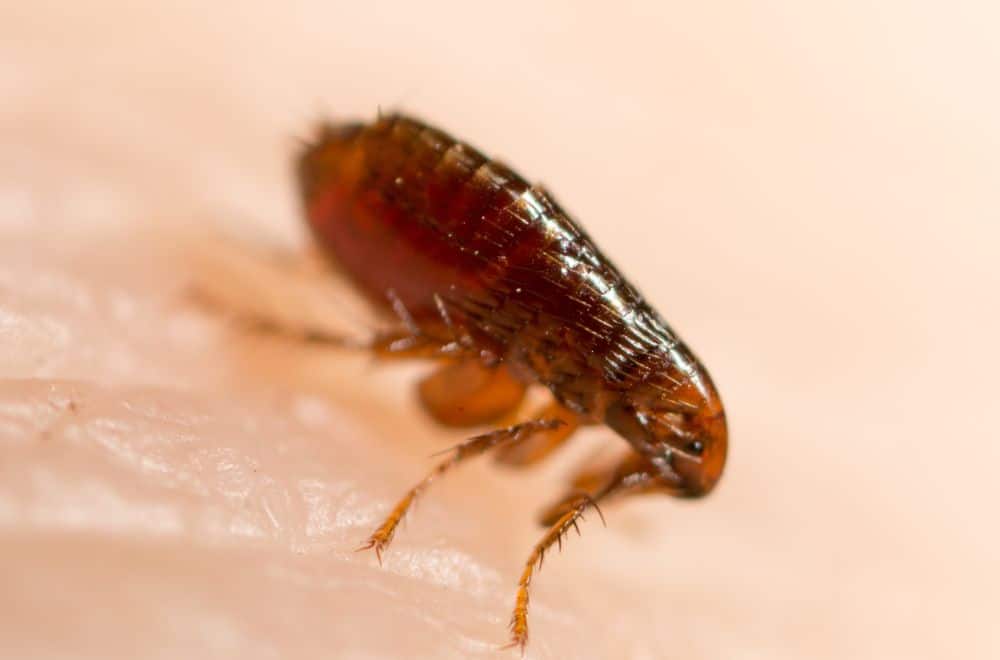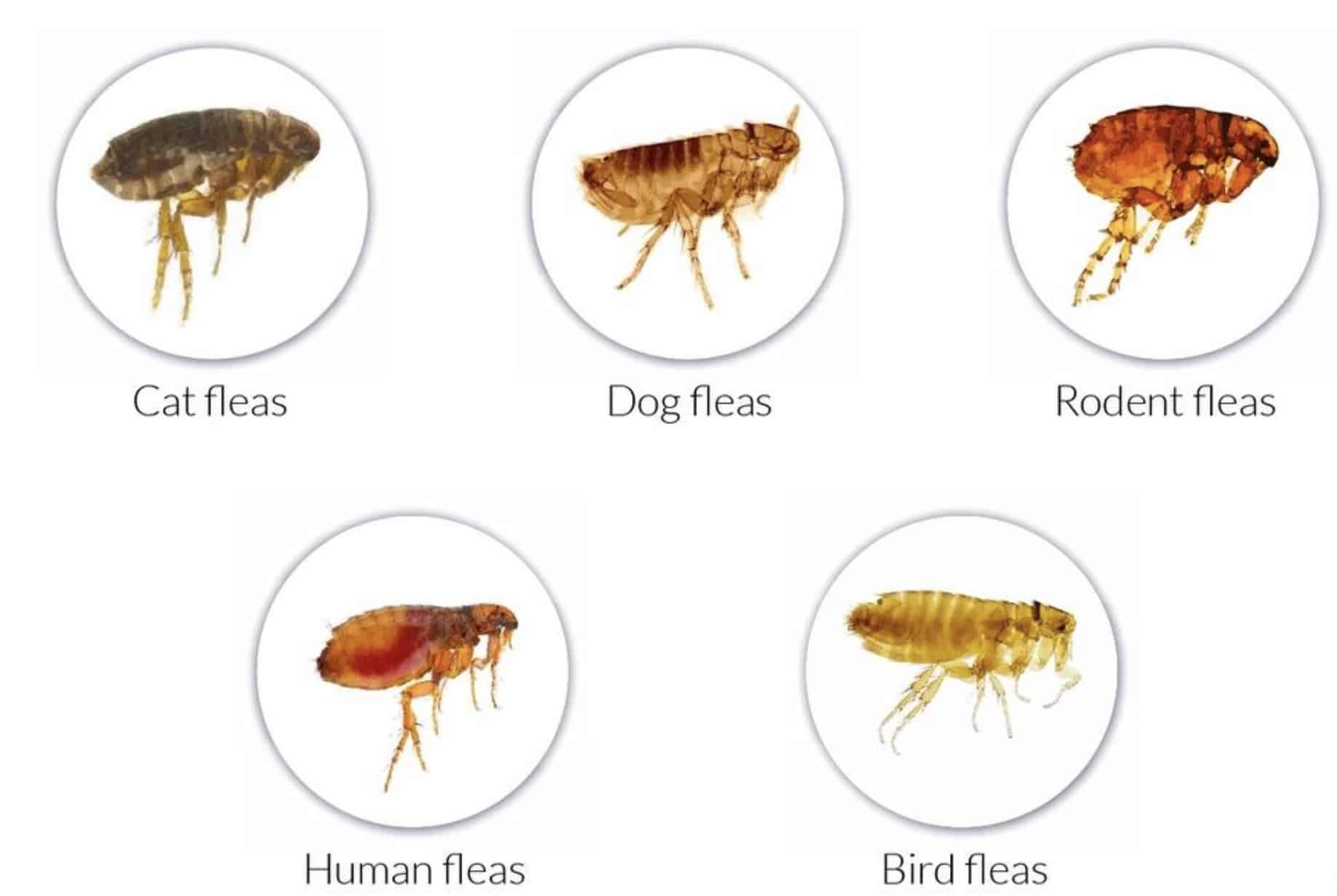Fleas are horrible tiny, 0.03 inches (0.76 mm) long bugs that feed on blood and spread numerous diseases. The most severe infections include tapeworms, typhus, and cat scratch disease.
Once they appear in bed, they will start biting you even though you are unaware of their presence. Discovering the first signs of fleas in bed and getting rid of them before causing infestations in the entire house is vital.
What Are Fleas?
Fleas (Siphonaptera) are external parasites sucking the blood of humans, other mammals, and birds. Besides feeding on blood, both larvae and adults often consume other fleas’ feces since they are full of blood residues.
Nowadays, it is possible to recognize about 2,200 to 2,500 species that look and behave differently. Only three are common in the US, including:
- Human fleas (Pulex irritans)
- Cat fleas (Ctenocephalides felis)
- Cog fleas (Ctenocephalides canis)
Their life cycle lasts approximately 20 to 35 days, and each flea goes through four life stages.
Eggs
Fleas lay eggs after a reproducing period that occurs in the following periods:
- The spring, summer, and early autumn when living outside
- Throughout the year, when living indoors
Female fleas can lay 40 to 50 off-white eggs daily. You can see them on your dark-colored linen as grains of salt. Eggs transform into larvae after one to 10 days, depending on the temperature and humidity in their environment.
Larvae
Initially, 0.19 inches (4.8 mm) long flea larvae are white but become yellow to brown in the end. The larval stage typically lasts 4 to 18 days, when they transform to silken cocoons, and the pupae stage appears.
Pupae
Pupae can remind you of flea dirt. This stage is weird since it lasts only three days or is prolonged for 12 months. Knowing they can spend a year in your bed, enjoying warm conditions, and transform into adults anytime is scary. The final stage starts when the environmental conditions are favorable.
Adults
They are typically reddish-brown and have six legs but not wings. Believe it or not, they can jump up to 13 inches (2.54 cm) thanks to their long hind legs. It is 200 times longer than their body length! You can identify particular species by:
Color – Most flea species come in a dark brown shade, while their body is oval-shaped and flattened. Even though these insects are visible to the naked eye, it is unlikely to recognize a particular type only based on color. However, it can be helpful to differentiate them from other bugs.
Size – Fleas are tiny creatures that vary in size, depending on the species. Most adults are not longer than 0.04 to 0.16 inches (1 – 4 mm), while the tiniest Chigoe fleas are only 0.02 to 0.05 inches (0.5 – 1.15 mm) in length.
The most sizable are some bird fleas that can reach 0.3 inches (8 mm). Be prepared to use a magnifying glass to try to recognize this trait.
Signs of Fleas in Bed
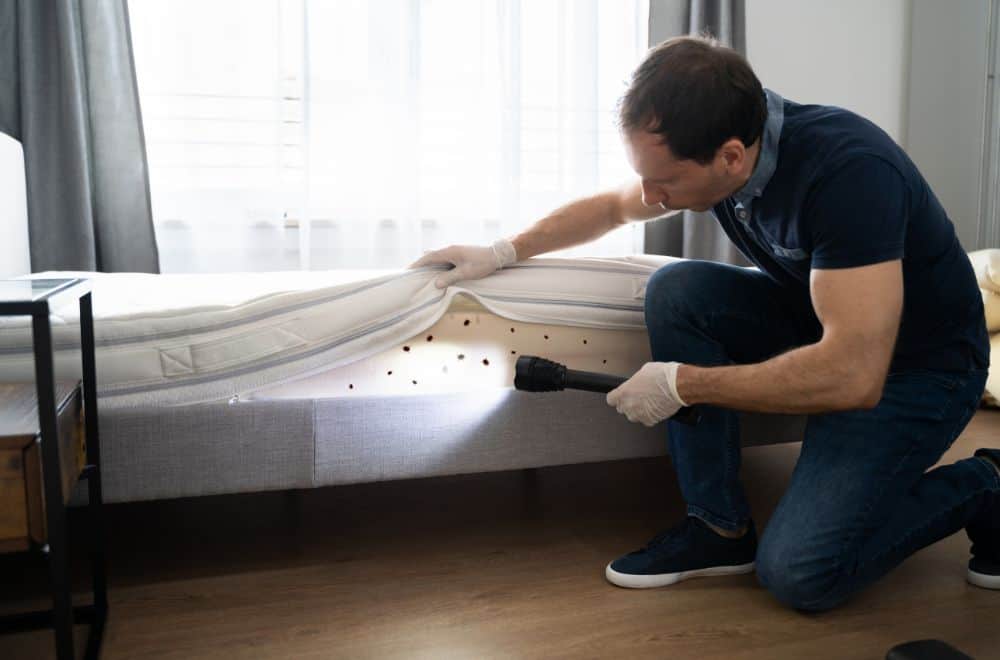
Fleas quickly enter homes in a few ways:
- Through cracks in walls and open windows and doors
- Via your pets or stray cats and dogs
- Carried by wildlife, like squirrels, raccoons, pigeons, opossums, foxes, or rats
- Attached to human shoes or clothes
- Inside the luggage
Once they enter the house, they will quickly find their way to spaces suitable for reproducing. From there, it is just one step to your bed.
Fleas typically bite animals and suck their blood, and attack humans only when their primary food source is unavailable. They enjoy the warm environment your bed provides and leave dirty marks all over the sheets and bed parts.
Once you suspect there are fleas in your bed, it is necessary to confirm their presence. Only that way you can fight these horrible tiny creatures. Your first step should be to find signs that prove they are in your bed by:
Looking for bite marks on your body
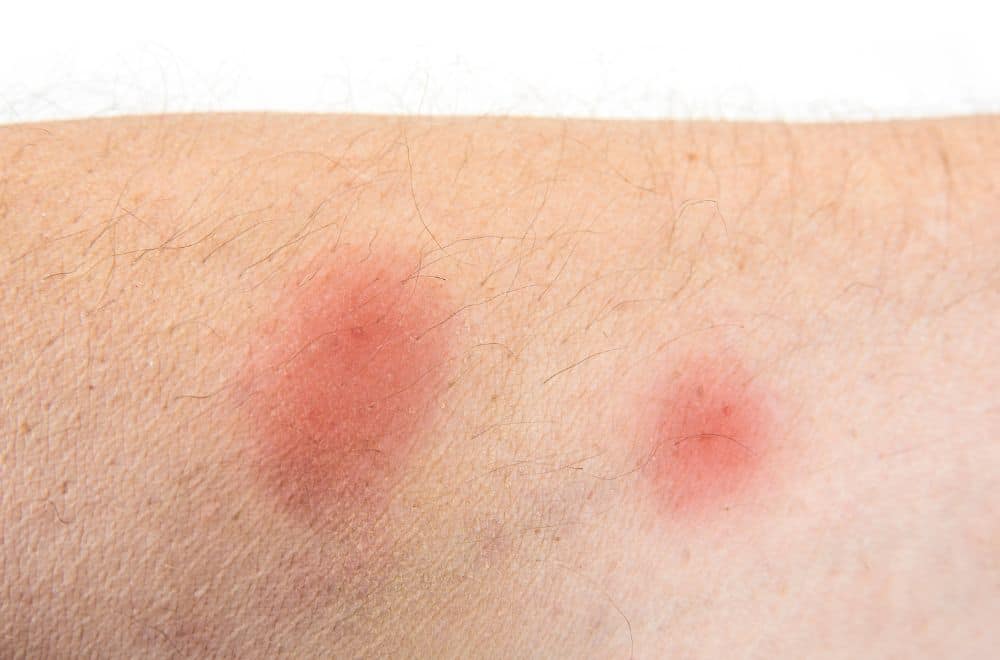
If fleas live in your bed, you will quickly face itch and red circle marks on your torso, feet, and ankles.
It is crucial to determine whether they are a result of accidental contact with these insects or their stay in your bedding. Once you become a victim of flea invasion, you will find one or more red spots on the skin:
1. One bite mark – It can be a flea bite, but it is unlikely because these creatures tend to nibble the skin multiple times.
2. Multiple bites – They are almost a sure sign that you have these annoying insects in your bed. Even though you can find them anywhere on your body, the primary spots are on your feet and ankles due to thin skin and easily accessible blood vessels.
Besides red marks, you can suffer from other symptoms, such as:
- Persistent and intense itching
- Swollen and raised red skin in the bite area
- Anaphylaxis (life-threatening allergic reaction) in some cases
- Bacterial infection followed by fever, rashes, nausea, and vomiting
Checking your bedding
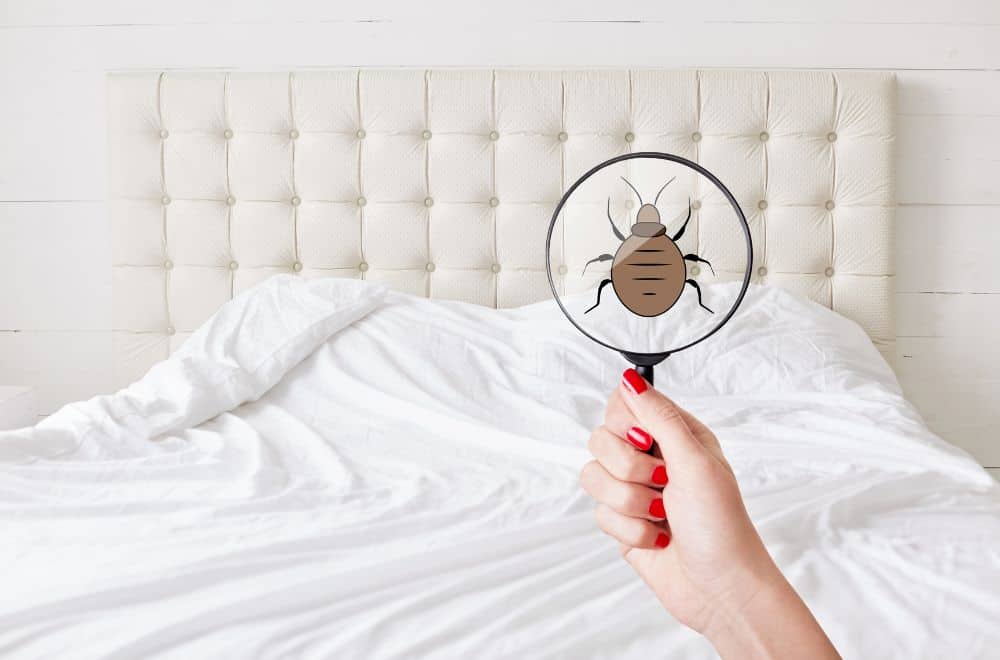
Fleas can live in your bed for months, sometimes a year, when a host provides the necessary food. On the other hand, they will die in a few weeks without blood. So, avoiding sleeping in your bed for a while will result in dead fleas between the linen.
However, fleas’ lifespan is often shorter since people discover these menaces sooner or later and find a way to eliminate them. Be aware that spotting fleas jumping around is not the only way to conclude you have an infestation in your bed.
In fact, there are several possibilities. Therefore, it is crucial to remove the sheets and thoroughly inspect the seams, bed corners, mattress, and upholstered parts, if any.
3. Flea dirt all over the bed
In case of a flea infestation, you can find visible feces traces on your linen, mainly when using light-colored bedding. You should also check pillow covers, a headboard, and a bed frame for tiny black pepper-like dots to confirm your doubts.
Be careful with this dirt since it can cause an allergic reaction and infections. Additionally, flea larvae feed on this dirt, producing new adults and worsening the existing situation.
Their feces can be red or black, depending on their last meal. You can confirm it is flea dirt by washing sheets in mild water or wiping them with a wet paper towel. They can remove dirt but not the red blood traces on the surface.
4. Flea eggs on the bed
Flea eggs’ existence on your bed is an undoubtful indication adults live between your sheets and inside the bed frame. However, you need to know what to look for since they are too small, and finding them can be challenging.
Be aware that flea eggs’ size is only 0.02 inches (0.5 mm), reminding an elongated grain of salt gathered in clusters of 4 to 8. You can easily overlook them on the light linen because they are so tiny and pearly white.
The best way is to check your bed with a lint roller since they become visible on the contrasting surface. After a few days, they turn into larvae.
5. Flea larvae on the bed
Off-white flea larvae are worm-like creatures with brown heads. You can see them crawling across your bed.
6. Flea pupae on the bed
Pupae are white to light brown cocoons with fleas sitting inside a thin pupal cuticle. Adult fleas can survive for months in this stage while waiting for a host.
7. Flea skin on the bed
Flea skin residue comes from flea larvae or pupae after the molting process. Both molt twice (four times in total), leaving whitish traces on the bedding before adults appear. Unfortunately, these cylindrical-shaped skin traces are only visible under a magnifying glass or microscope.
8. Adult fleas on the bed
Dark reddish-brown, oval-shaped adult fleas are the most effortless to spot on the bed. Be aware that one single adult flea may lead to a severe invasion in a short period.
For instance, one adult female begins laying eggs 24 to 48 hours after the first blood meal. It can produce approximately 40 to 50 eggs for a day, reaching an unbelievable 400 to 900 eggs during her two to three-month-long lifespan.
The best way to check whether they are in your bed is to attract them with light or heat. One helpful trick includes a white sock. Roll it over the bed until attracting fleas possibly present there.
Another option is to use a flashlight turned toward insects you see. Fleas will start jumping on the light source if you have an issue with infestation.
9. Dark spots on bed sheets
You can suspect dead fleas if there are unusual dark spots on your bedding. It often happens that sleepers kill them during the night.
10. Pet fur on the bed
Pet fur typically occurs on the bed after your pet scratches along its edges or sleeps on your sheets. Losing fur is a natural process in cats and dogs, but excessive hair loss in a short period is a warning sign. In most cases, it is probably a flea invasion, particularly when you fail to protect your pet in time.
Examining your pet
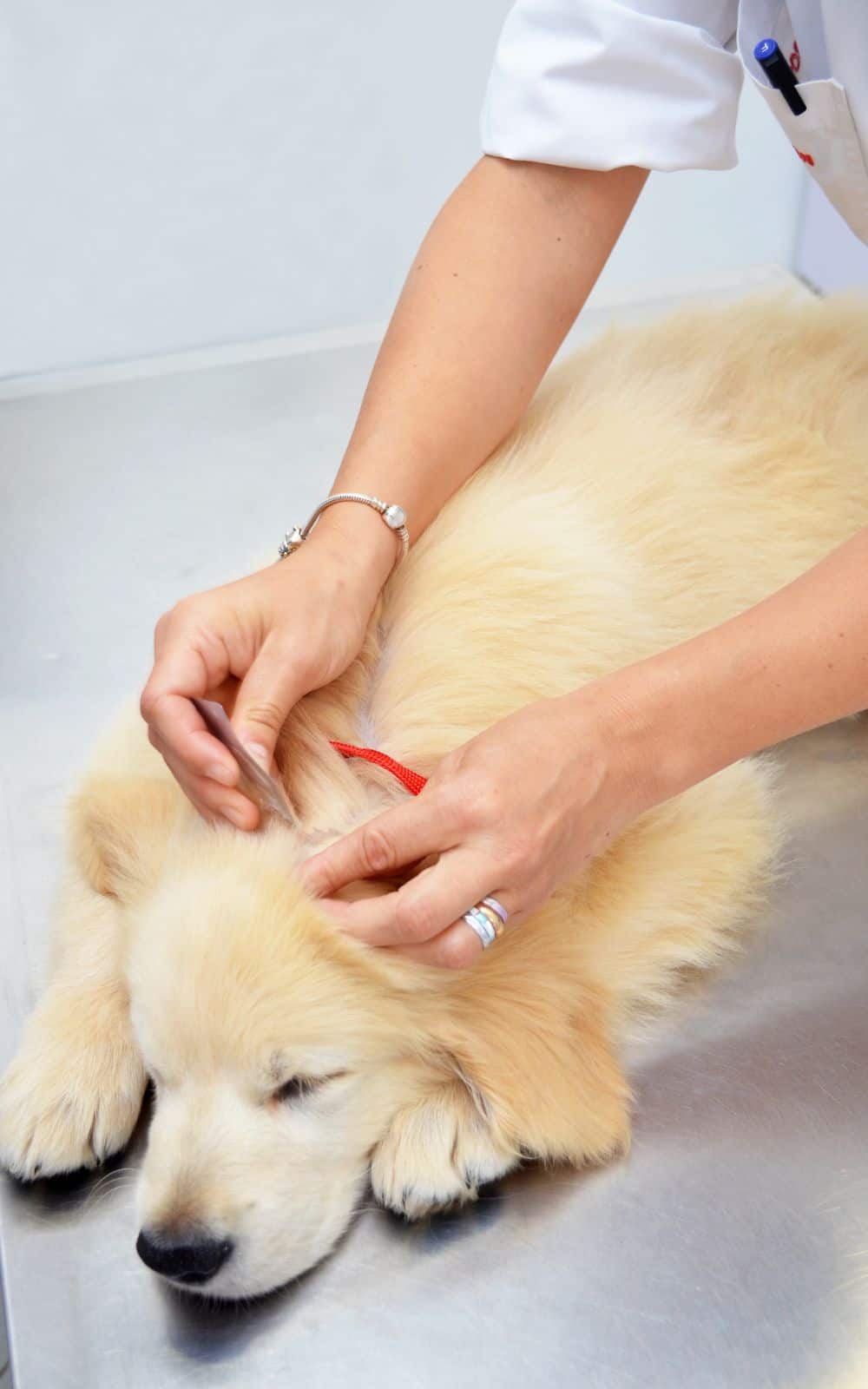
In case your pet is infected, you can notice several symptoms typical for this health condition:
- Persistent scratching
- Red skin patches and whitish marks of scratching under the fur
- Excessive hair loss
- Pale gums
- Restlessness as a result of skin irritation and itching
When a flea infestation is at an advanced stage, your pet will become lethargic with symptoms like:
- Low biting force
- Low energy levels
- Sleepiness
- Loss of appetite and weight loss
- Black stools
- Anemia
Flea Types Possibly Present In Your Bed
The most common flea types you can find in your bed are:
1. Dog fleas
These 0.04 to 0.16 inches (1 – 4 mm) long dark brown or black fleas are the most common types found on beds. They are typical for dog owners, particularly when your pet sleeps with you.
Don’t be swayed if you notice reddish fleas on your bedding because they change color after sucking blood. Unfortunately, this species is highly dangerous for human and dog health since it transmits tapeworms.
2. Cat fleas
These dark brown creatures are 0.04 to 0.12 inches (1 – 3 mm) long and differ from other species by:
- Pronotal combs behind their heads
- Genal combs placed above the mouth
This flea type primarily feeds on cat blood but sometimes can bite you, as well.
3. Human fleas
This 0.04 to 0.16 inches (1 – 4 mm) long flea type has an elongated proboscis for feeding that pierces the host skin. It makes biting people and sucking their blood through the epipharynx effortless.
The bite causes skin irritation and can be crucial in bacteria transmission. This species probably come from South America and can quickly switch from people to animals, particularly pigs.
4. Rat fleas
Finding 0.08 to 0.1 inches (2 – 2.5 mm) long rat fleas in the bed is uncommon, but it is possible if you have rodents in the house. Since insects are in close contact with their blood, they may spread various diseases, including typhus and horrible bubonic plague.
5. Bird fleas
These fleas are brown, with a size that varies according to the bird host. You can find small insects of only 0.04 inches (1 mm) in chickens and pigeons, while those appearing on farms can reach a length of 0.3 inches (8 mm).
6. Chigoe (sand) fleas
Chigoe fleas living in hot tropical and subtropical regions prefer sucking human blood. Therefore, these 0.02 to 0.05 inches (0.5 – 1.15 mm) long creatures are common guests in beds. This species’ females are responsible for transmitting an inflammatory skin disease, tungiasis.
7. Sitckfight fleas
This flea species attacking humans, cats, dogs, horses, and poultry originated in Australia. They are approximately 0.08 inches (2 mm) long before feeding. Sticktight fleas don’t transmit diseases but can often cause deadly secondary infections after attaching to the skin.
Summary
Sometimes, you can face flea infestation in your bed after you or your pets bring them inside the house. These tiny insects typically live on hosts, like humans and animals, but they can survive about six weeks in bed without food. Since they transmit a few severe diseases, it is crucial to discover and eliminate them immediately.
